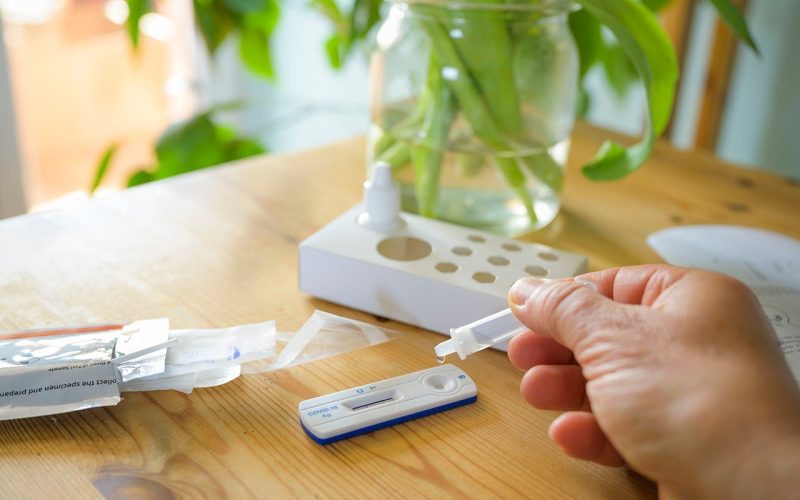Research from the Netherlands has revealed that in individuals with Covid-19 like symptoms, the sensitivities of three commercially available corona self-tests performed with nasal self-sampling decreased during the emergence of the Omicron variant. However, self-sampling in nose plus throat led to an increase of the accuracy of the self-tests. These findings indicate that nose combined with throat self-sampling is beneficial for the investigated self-tests. However, this is not yet in accordance with the current instructions for use and registration of the self-test.
When developing Covid-19 like symptoms, self-testing is widely advocated. Currently, the performance of these self-tests for detecting the Omicron corona virus is largely unknown. In addition, it is unclear whether an extra self-sample from the throat, in addition to the standard self-sample from both nostrils, increases the accuracy (i.e. the sensitivity) of the self-test to detect an infection with the Omicron corona virus. A large group of Dutch investigators under leadership of the UMC Utrecht investigated in almost 6,500 individuals with corona like symptoms, three commercially available and used corona self-tests from Acon Labs (‘Flowflex’), MP Biomedicals (‘MPbio’), and Siemens-Healthineers (‘Clinitest’). The study was conducted from mid-December 2021 to mid-February 2022, during and after the emergence of the Omicron virus variant. At the test site, participants first underwent a PCR test (the so-called reference standard) and then received one of the self-tests to use at home within three hours after visiting the test site. In the first part of the study, participants were asked to perform self-sampling in the nose. In the second part, participants were asked to perform self-sampling in the throat first, and then in the nose. The latter could only be studied for two of the three self-tests (MPBio and Clinitest).
For the detection of the Omicron virus, overall sensitivities for self-sampling in the nose were 79 percent for Flowflex, 70 percent for MPBio, and 70 percent for Clinitest. These sensitivities were substantially higher (94, 84 and 86 percent, respectively) in the so-called confirmatory testers (people who visited the test site to undergo a PCR test because they had a recent positive self-test), than in those that visited the test site for other reasons (52, 52 and 50 percent, respectively). Further analysis showed that sensitivities decreased by 6, 7 and 13 percent points, respectively, when comparing the period with Delta dominance to the period with Omicron dominance.
Epidemiologist prof. Carl Moons PhD, principal investigator of the study, interprets the findings as follows: “In individuals with corona like symptoms and when using only nose self-sampling, the sensitivity of these three self-tests was somewhat lower in the Omicron dominant weeks of our study as compared to the Delta dominant weeks”.
During the study, suggestions rose that detecting infection with the Omicron corona virus by self-testing might be improved by extra self-sampling from the throat. This triggered the researchers to immediately extend their study to investigate whether addition of throat self-sampling indeed increases the sensitivity of corona self-tests in the Omicron era. The study showed that, when people used both throat and nose self-sampling, the overall sensitivities increased from 70 to 83 percent for MPBio and from 70 to 77 percent for Clinitest. Carl Moons continues: “Our well-established infrastructure provided the unique opportunity to become the first large study to investigate the added value of throat to nose self-sampling. We indeed found that addition of throat self-sampling increases the sensitivity of the investigated self-tests”. We do not yet advise people to do this themselves, as these tests are not yet registered for this purpose.”
This study, funded by the Dutch Ministry of Health, Welfare and Sport, was a collaboration between UMC Utrecht, Cochrane Netherlands, Microvida, GGD (West-Brabant, Hart voor Brabant and Rotterdam-Rijnmond), Erasmus MC, Reinier Haga Medical Diagnostic Center, Sanquin Blood Supply and RIVM.
Schuit E, Venekamp RP, Hooft L, Veldhuijzen IK, Bijllaardt W van den, Pas SD, Zwart VF, Lodder EB, Hellwich M, Koppelman M, Molenkamp R, Wijers C, Vroom IH, Smeets LC, Nagel-Imming CRS, Hof S van den, Kluytmans JAJW, Wijgert JHHM van de, Moons KGM. Accuracy of three COVID-19 self-tests with unsupervised nasal self-sampling and the added value of oropharyngeal self-sampling in symptomatic individuals in the Omicron period. Manuscript available at https://medrxiv.org/cgi/content/short/2022.03.24.22272891v1
